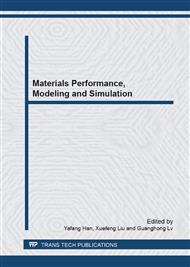[1]
A. Mondal, A. Upadhyaya, D. Agrawal, Comparative study of densification and microstructural development in W-18Cu composites using microwave and conventional heating, Materials Research Innovations. 14 (2010) 355-360.
DOI: 10.1179/143307510x12820854748638
Google Scholar
[2]
M. Zohoor, A. Mehdipoor, Explosive compaction of tungsten powder using a converging underwater shock wave, Journal of materials processing technology. 209 (2009) 4201-4206.
DOI: 10.1016/j.jmatprotec.2008.11.031
Google Scholar
[3]
M. Zohoor, A. Mehdipoor, Comparative study on particles bonding of tungsten samples which produced by powder metallurgy method and underwater explosive compaction technique, Metalurgija-Journal of metallurgy. 13 (2007) 197-202.
DOI: 10.4028/www.scientific.net/msf.566.77
Google Scholar
[4]
L.J. Kecskes, I.W. Hall, Hot Explosvie Consolidation of W-Ti Alloys, Metallurgical and Materials Transactions A. 26 (1995) 2407-2414.
DOI: 10.1007/bf02671254
Google Scholar
[5]
L.J. Kecskes, I.W. Hall, Microstructural effects in hot-explosively-consolidated W-Ti alloys, Journal of Materials Processing Technology. 94 (1999) 247-260.
DOI: 10.1016/s0924-0136(99)00077-1
Google Scholar
[6]
L.J. Kecskes, Hot Explosive Consolidation of Mo-Ti and W-Ti Alloys, Materials and Manufacturing Process. 14 (1999) 123-145.
DOI: 10.1080/10426919908914809
Google Scholar
[7]
F.D.S. Marquis, A. Mahajan, A.G. Mamalis, Shock synthesis and densification of tungsten based heavy alloys, Journal of Materials Processing Technology. 161 (2005) 113-120.
DOI: 10.1016/j.jmatprotec.2004.07.060
Google Scholar
[8]
Y. Kim, K. Hokamoto, S. Itoh, Optimal design of shock compaction device, Materials science forum. 566 (2008) 339-344.
DOI: 10.4028/www.scientific.net/msf.566.339
Google Scholar
[9]
S. Itoh, The industrial Applications of Underwater Shock Wave, Materials science forum. 566 (2008) 361-372.
DOI: 10.4028/www.scientific.net/msf.566.361
Google Scholar
[10]
S. Itoh, S. Kubota, S. Nagano, I. Morita, A. Chiba, M. Fujita, An Investigation of Converging Underwater Shock Wave Using High Speed Photography, SPIE. 2513 (1995) 772-781.
DOI: 10.1117/12.209674
Google Scholar
[11]
S. Tanaka, K. Hokamoto, M. Fujita, S. Itoh, T. Mashimo, Development of high-temperature shock compression system for consolidating powders by the use of underwater shock-wave assembly, Physica B. 239(1997) 16-18.
DOI: 10.1016/s0921-4526(97)00368-2
Google Scholar
[12]
K. Hokamoto, et al., Hot Shock Consolidation of Diamond and Cubic Boron Nitride Powders, in: Proceedings of Shock Wave and High Strain Rate Phenomena in Materials, 1992, New York, pp.453-462.
Google Scholar
[13]
Q. Zhou, P.W. Chen, X. Gao, W.P. Shen, Experiment Study on the Hot-shock Consolidation of Tungsten Powder, Materials science forum. 673 (2011) 107-112.
DOI: 10.4028/www.scientific.net/msf.673.107
Google Scholar
[14]
Z.M. Jiang, P.W. Chen, P.F. Wang, J. Yang, W.P. Shen, Combustion Synthesis Assisted Explosive Consolidation of Mo/Cu FGM, Transaction of Beijing Institute of Technology. 27 (2007) 108-112.
Google Scholar
[15]
Q. Zhou, P.W. Chen, X. Gao, Fabrication of Tungsten-Copper Composites by Hot-Shock Consolidation, in: Proceedings of the Conference of the American Physical Society Topical Group on Shock Compression of Condensed Matter, AIP Conference Proceedings, Chicago, 2012, pp.1347-1350.
DOI: 10.1063/1.3686530
Google Scholar
[16]
N. Jia, Z.H. Cong, X. Sun, S. Cheng, Z.H. Nie, Y. Ren, P.K. Liaw, Y.D. Wang, An in situ high-energy X-ray diffraction study of micromechanical behavior of multiple phased in advanced high-strength steels, Acta Materialia. 57 (2009) 3965-3977.
DOI: 10.1016/j.actamat.2009.05.002
Google Scholar


